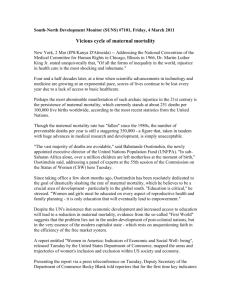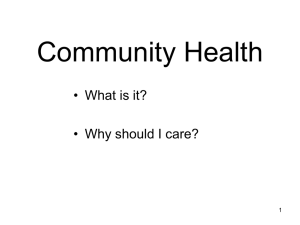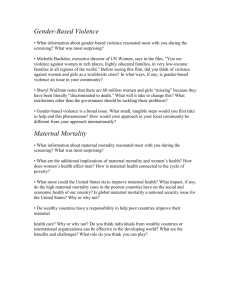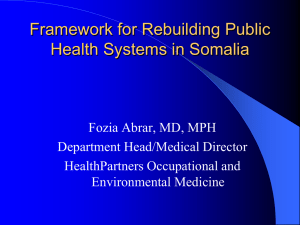Population Change and Public Health Exercise 11A under the new paradigm
advertisement
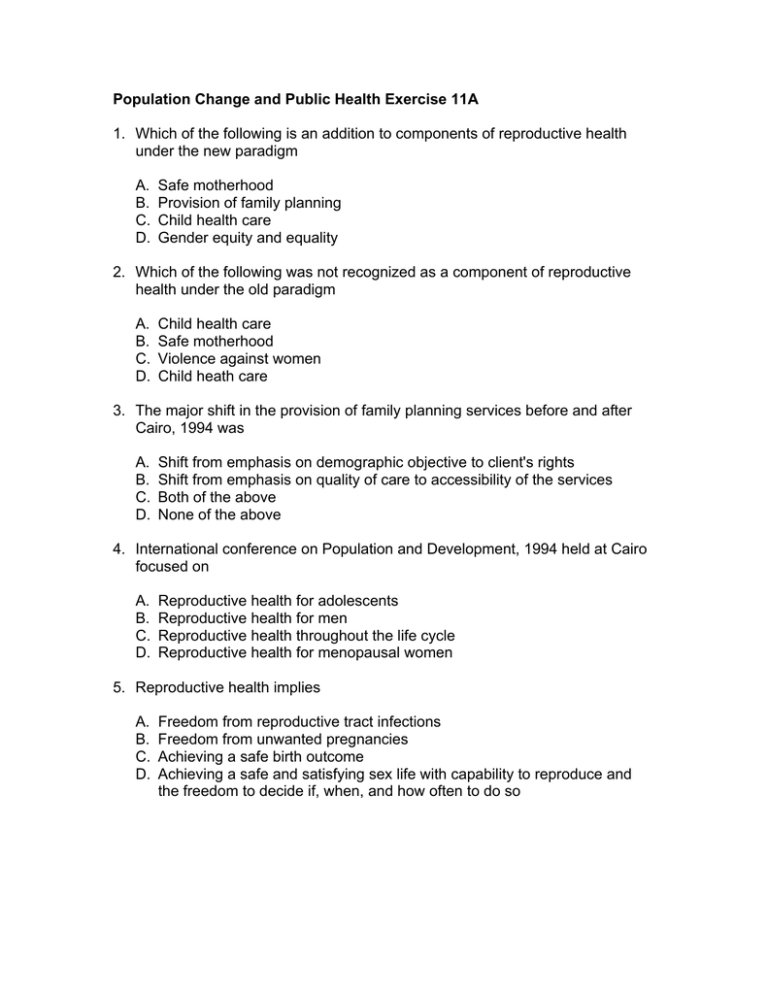
Population Change and Public Health Exercise 11A 1. Which of the following is an addition to components of reproductive health under the new paradigm A. B. C. D. Safe motherhood Provision of family planning Child health care Gender equity and equality 2. Which of the following was not recognized as a component of reproductive health under the old paradigm A. B. C. D. Child health care Safe motherhood Violence against women Child heath care 3. The major shift in the provision of family planning services before and after Cairo, 1994 was A. B. C. D. Shift from emphasis on demographic objective to client's rights Shift from emphasis on quality of care to accessibility of the services Both of the above None of the above 4. International conference on Population and Development, 1994 held at Cairo focused on A. B. C. D. Reproductive health for adolescents Reproductive health for men Reproductive health throughout the life cycle Reproductive health for menopausal women 5. Reproductive health implies A. B. C. D. Freedom from reproductive tract infections Freedom from unwanted pregnancies Achieving a safe birth outcome Achieving a safe and satisfying sex life with capability to reproduce and the freedom to decide if, when, and how often to do so Population Change and Public Health Exercise 11B 1. The standard definition of Unmet need includes all of the following except A. Married women B. Infecund women C. All married pregnant women D. All married postpartum amenorrheic women 2. Unmet need for family planning is the A. Proportion of women who want to use contraception but are not using at the time of survey B. Proportion of women who want to space the next birth or want to cease childbearing altogether but are not using contraception at the time of survey C. Proportion of women who want to use contraception but are not able to get the services D. Proportion of women who do not want any more children and are using contraception at the time of survey 3. Unmet need for family planning is highest in A. Africa B. Latin America and Carribean countries C. Asia D. North America and Europe 4. A current survey reveals high levels of unmet need for family planning in a country. This implies that A. There is a need to open more clinics to provide family planning services B. The attitude of the women is favorable to the use of contraceptive methods C. The fertility will be lower in this country compared to another country with low levels of unmet need D. None of the above 5. Which of the following has not been recognized as a reason for unmet need in the country? A. Lack of access to family planning services and poor quality of services B. Health concerns C. Lack of information and misinformation about contraceptive methods D. Use of contraception in the past 6. A country has a very high fertility rate and a very low unmet need for contraception. This implies that A. Women have very high fertility preferences B. Women have very low fertility preferences C. Both of the above D. None of the above 7. With increasing demand for family planning, the unmet need for contraception A. Will first increase and then decline over time B. Will first decline and then increase over time C. Will stay the same D. Will keep declining 8. Which of the following is a programmatic strategy to address unmet need A. Improve accessibility and quality of the family planning services B. Design communication programs to provide accurate information on different contraceptive methods C. Involve men, religious leaders and other important actors to overcome any cultural, social and other barriers to use of family planning D. All of the above 9. Levels of unmet need suggests that there is a A. Actual demand for contraceptive methods in the population B. Potential demand for contraceptive methods in the population C. All these women who stated an unmet need will start using contraceptive once provided for the services D. None of the above 10. In Sub-Saharan Africa, the demand for spacing methods A. Exceeds that for limiting the births B. Is lower than that for limiting the births C. Is equal to that for limiting the births D. None of the above Population Change and Public Health Exercise 11C 1. Most common cause of maternal mortality is A. Post- partum hemorrhage B. Eclampsia C. Other systematic conditions D. Infections 2. The maternal mortality ratio per 100000 live births for sub-Saharan Africa lies in the range A. 100-200 B. 200-400 C. 500-1000 D. 5000-7000 3. Family planning helps to make motherhood safe by all of the following except A. Helping to prevent unwanted pregnancies and hence unsafe abortions B. Reducing the incidence of STDs which may have adverse effect on birth outcomes C. Reducing the incidence of post-partum bleeding D. Reducing the incidence of high risk pregnancies 4. If the fertility goes down, which of the following is most affected assuming that high fertility is associated with maternal mortality A. Both Maternal mortality ratio and rate B. Only maternal mortality ratio C. Only maternal mortality rate D. None of them 5. Which of the following health indicators exhibits largest disparities between developed and developing countries A. Infant mortality rate B. Crude death rate C. Maternal mortality rate D. Under 5 mortality rate 6. Which of the following delays resulting in maternal mortality is easiest to address programmatically? A. First delay due to ignorance or other cultural traditions resulting in delay in decision to seek care B. Delay in reaching a health facility C. Delay in receiving care after reaching a health facility D. All of the above 7. Which of the following is not a commonly used indicator for safe motherhood programs A. B. C. D. Percent of mothers receiving maternal care Percentage of births attended by skilled health personnel Under 5 mortality rate Maternal mortality rate 8. Hemorrhage, obstructed labor, Eclampsia and unsafe abortion account for almost more than half of maternal deaths. This implies A. That training traditional birth attendants without increasing access to emergency obstetric care will have significant impact on reducing the maternal mortality B. That training traditional birth attendants will not have any effect on maternal mortality C. That training traditional birth attendants in identifying high risk cases during antenatal period and complications during delivery can help to reduce maternal mortality if accompanied by increased access to emergency obstetric care D. None of the above 9. The empirical data regarding skilled delivery care and maternal mortality shows A. No relationship B. A consistent inverse relationship C. A consistent direct relationship D. A parabolic relationship 10. The most important programmatic challenge to reduce maternal mortality in developing A. To overcome certain cultural practices which are harmful to mother's deaths B. Ensuring accessible emergency obstetric services 24 hours a day C. To ensure presence of women medical personnel in the rural areas D. None of the above Population Change and Public Health Exercise 11D 1. The most common type of sexually transmitted infection is A. Chlamydia B. Trichomoniasis C. Gonorrhea D. HIV 2. The demographic impact of HIV in Sub-Saharan has resulted in (check all that apply) A. Negative population growth rates B. Decline in life expectancy at birth C. Increase in crude rate of natural increase D. Decline in population growth rates 3. The age group most commonly affected by Sexually transmitted diseases is A. 15-24 B. 25-29 C. 30-34 D. More than 40 years 4. The most important two causes of health years lost for women in reproductive age group in developing countries are: A. Malaria and tuberculosis B. Maternal causes and sexually transmitted diseases C. Tuberculosis and HIV D. Mental illnesses and sexually transmitted diseases 5. Programs designed to reduce the incidence of sexually transmitted diseases will have the effect on all of the following except A. Reduction in the prevalence of infertility B. Reduction in the prevalence of low birth weight babies and still births C. Reduction in incidence rate of cervical cancer in women D. Reduction in the fertility rates 6. The most important obstacle to instituting community based public health programs for control of sexually transmitted diseases is A. Lack of effective treatment for most of these diseases B. Large proportion of asymptomatic cases with lack of non-invasive tests to diagnose them C. Long incubation period for most diseases D. Lack of effective preventive measures for most of these diseases 7. Which of the following is not true of STDs transmission among men and women A. Women are less susceptible than men to acquisition of STDs B. Women are more susceptible than men to acquisition of STDs C. Women are more likely to have more frequent and more serious long term complications D. Women are more likely to have asymptomatic infections 8. Which of the following is an incurable sexually transmitted disease? A. Syphilis B. Chlamydia C. Human Papilloma Virus D. Trichomoniasis 9. All of the following are complications of sexually transmitted diseases except A. Still birth or premature birth B. Cancers C. Mental disorders D. Infertility 10. Which of the following is true of management of sexually transmitted infections in the developing country setting A. Most of the diseases can be easily diagnosed and treated by paramedical workers in the field B. Most of these diseases present as asymptomatic cases and their diagnosis requires sophisticated laboratory facilities and expensive tests C. Cheap screening tests are widely available to be used in the field conditions in the developing countries D. Most of the common bacterial sexually transmitted diseases are incurable 11. The highest prevalence rates for HIV/AIDS are observed in A. Asia B. Sub-Saharan Africa C. Latin America D. Europe Population Change and Public Health Exercise 11E 1. Check all the harmful traditional reproductive health practices A. Female genital mutilation B. Dry vaginal douching C. Prolonged breast feeding D. Not feeding the infant with the colostrum 2. 'Gender' A. Concerns only women B. Refers to the biological differences between men and women C. The concept and manifestations are the same in all the societies D. Can influence the reproductive health outcomes for the women 3. Adolescent health is gaining importance due to A. Most common age group affected by sexually transmitted diseases and other reproductive health risks B. Is easily accessible and more amenable to interventions C. Comprises a small proportion of age group in most developing countries D. None of the above 4. Which of the following is not a special reproductive health risk among adolescents? A. Unsafe abortion B. Sexually transmitted infection C. High maternal mortality D. Higher incidence of side effects of modern contraceptives 5. Female genital cutting involves A. Partial or total removal of female internal genitalia B. Partial or total removal of female external genitalia C. Partial removal of vagina D. Partial removal of cervix 6. Female genital cutting is more common among A. Higher socio-economic groups in the populations in the countries where it is prevalent B. Lower socio-economic groups in the populations in the countries where it is prevalent C. Accepted among all socio-economic strata in the countries where it is prevalent D. None of the above 7. Which of the following can be used to measure gender in a particular society A. Male and female educational differentials B. Spousal age difference at the time of marriage C. Labor force participation rates for men and women D. All of the above


